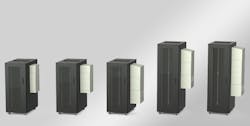Self-Contained Cooling Unleashes Compute Power at the Edge
In this edition of Voices of the Industry, Kevin Jackson, National Sales Manager at Emcor Enclosures discusses a cost-effective and highly efficient approach to server cooling in sub-optimal conditions. The solution integrates air conditioning directly into server cabinets.
Kevin Jackson, National Sales Manager at Emcor Enclosures
Computing isn’t always convenient.
While most data centers have the luxury of sophisticated thermal controls, that isn’t always the case with servers in the field. Consider the college dorm administrator who wants to provide an on-site server for computer science students to run machine learning algorithms. At many academic institutions, most residential facilities were built years before data centers existed. The infrastructure to cool sensitive equipment economically is either impractical or cost-prohibitive.
The same is true of many small businesses that rent office space or even operate out of homes. Owners can’t afford to retrofit their facilities with extensive environmental equipment and physical limitations may make it all but impossible for them to do so. I’ve seen situations in which equipment was stuffed into utility closets, under desks and even crammed into bathrooms. That’s a disaster waiting to happen.
Keep cool
The need to keep computing devices healthy in sub-optimal conditions will only grow as organizations move intelligence closer to the points of action at the edge of the network. The market for these edge computing services is expected to grow to nearly $16 billion by 2025 and involve a massive shift of computing power out of the data center.
One of the greatest challenges of maintaining equipment health in any environment is cooling. High temperature causes plastics, silicon and rubbers to soften, which affects their performance and reliability. Heat expansion can warm some internals, causing chips to fail and disks to experience read/write problems.
Heat also directly impacts performance. Modern CPUs have built-in protections that slow them down to prevent failure – a feature called “thermal throttling,” but tests conducted by Puget Systems showed that CPU frequencies fall dramatically the longer processors run at their maximum temperature. The frequency of a CPU running full throttle 100% of the time can fall by more than two-thirds.
Disk storage systems are extremely sensitive to heat and don’t have the same throttling features as CPUs. In addition to read/write problems, disks that run at high heat for an extended period of time are much more likely to fail. National Instruments has estimated that an increase of just 5°C above room ambient temperature can reduce a drive’s lifespan by up to two years.
One solution is to cool the equipment directly through a cost-effective and highly efficient approach that integrates air conditioning directly into server cabinets. This precision approach is optimal for remote locations, wiring closets, offices and industrial environments that don’t have the adequate thermal infrastructure. It’s been used in manufacturing scenarios for more than 40 years but is now being adapted to edge use cases.
Server rack cabinets can be pre-configured to accommodate a small air-conditioning unit mounted on either side. Customers just apply a gasket material and lift the unit into place. The units are so efficient that a 20-amp circuit is typically enough to power them. The power supply is intrinsic to the unit with cabling positioned out of the way at the cabinet bottom.
Drop-in simplicity
Customer-designed enclosures can make the transition from open racks to closed-loop, climate-controlled systems fast and easy by eliminating the need to re-terminate any equipment. The operator simply lifts equipment from a two-post frame rack and lowers it through the top of the enclosure, reattaches the rails and closes the top. Equipment is now properly house, cooled and secured with an ambient internal temperature of 75° to 85°F.
Communication cables can be connected through the top and terminated cables dropped into the sliding top cover. Once closed, compressible memory foam sheets impregnated with fire- and chemical-retardant seals eliminate airflow leaks. Condensation isn’t an issue because the closed-loop system evaporates moisture inside the air-conditioning unit itself.
Before purchasing a self-contained unit, consider your space limitations. A standard 42u rack may not fit under the seven-foot doorways that are common in older construction. If cabling is provisioned from the ceiling, be sure any unit you consider has a simple way to terminate cables inside the enclosure. Smaller units give you more flexibility by not only fitting into tighter spaces but enabling the entire assembly to be positioned on a raised surface.
Because edge environments don’t conform to data center standards, customization is often needed. Choosing a supplier that manufactures in the United States is a safer bet than sourcing overseas, particularly as supply chains are in flux during COVID-19.
Consider the advantage that edge computing can provide to your organization and the value of bringing computer resources closer to the people who need them. Now you can achieve those goals without the burden of worrying about heat-related equipment failure.
Kevin Jackson is the National Sales Manager at Emcor Enclosures. Choosing the right partner to help develop a solution to a customer problem can make or break any project. Emcor’s experienced team will work with you to quickly solve the problem without sacrificing quality and continue to improve on the solution once it has been developed.

